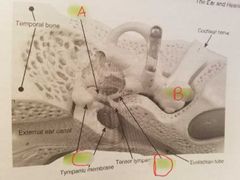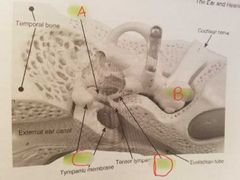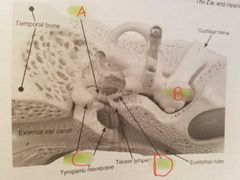![]()
![]()
![]()
Use LEFT and RIGHT arrow keys to navigate between flashcards;
Use UP and DOWN arrow keys to flip the card;
H to show hint;
A reads text to speech;
15 Cards in this Set
- Front
- Back
|
Used to help isolate the cause of hearing impairment. Patients who have become acclimated to their hearing loss. Vibrating tuning fork is held outside each ear (air conduction) and hearing is compared to the sound heard when placing the tuning fork handle on each mastoid process ( bone conduction). We normally hear at the tone better by air conduction. |
Rinne test |
|
|
A vibrating tuning fork is placed on the top of the skull in the midline, and the patient is asked to report the side of the head that the tone sounds louder. When the tuning fork is placed directly on the bone, there is no significant sound transmission from The Tuning Fork directly through the air because bone is denser than air. The conduction being tested is that through skull bones to the inner ear. |
Weber test |
|
|
Perception of sound in the absence of external stimulus. |
tinnitus |
|
|
Problems in the cochlea, the cochlear nerve, or neurons linking the cochlea to the auditory cortex of the brain. |
Sensorineural hearing loss |
|
|
Problems with the flow of air pressure waves through the ear canal, across the tympanic membrane, or through the ossicles. |
Conductive hearing loss |
|

A |
Incus |
|

B |
Cochlea |
|

C |
Malleus |
|

D |
Staples |
|
|
The ossicles amplify this mechanical pressure. The first bone, the ___(A)___, is attached to the tympanic membrane. This forms a rigid connection with the second ossicle, the ___(B)___. 1 this then articulates with the third ossicle, the ___(C)___. A? |
Malleus |
|
|
The ossicles amplify this mechanical pressure. The first bone, the ___(A)___, is attached to the tympanic membrane. This forms a rigid connection with the second ossicle, the ___(B)___. 1 this then articulates with the third ossicle, the ___(C)___. B? |
Incus |
|
|
The ossicles amplify this mechanical pressure. The first bone, the ___(A)___, is attached to the tympanic membrane. This forms a rigid connection with the second ossicle, the ___(B)___. 1 this then articulates with the third ossicle, the ___(C)___. C? |
Staples |
|
|
Inflammation of the auditory canal |
Otits externa |
|
|
Collects sound waves and funnel them into the ear canal. Also called auricle |
Pina |
|
|
The eardrum |
Tympanic membrane |

